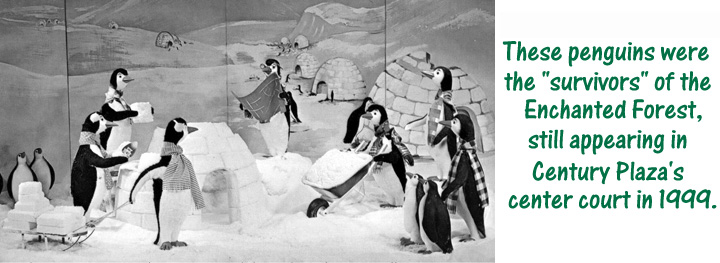By TIM HOLLIS Anyone who visited downtown Birmingham between Thanksgiving Day and Christmas Day unwittingly found themselves caught in the middle of a cheerful battlefield. The combatants were the two retail kings, Pizitz and Loveman's, and their rivalry was one that made Macy's and Gimbel's look like a couple of dime stores. This rivalry, of course, simmered throughout the year, but when the Christmas season approached, it blazed into all of its white-hot glory.
To store display director Joe Dultz fell the job of creating the first installment in what would become a longstanding downtown Christmas tradition. His initial approach was quite simple, at least in comparison with later years. Dultz purchased some second-hand window displays that had originally appeared at the Maison Blanche department store in New Orleans (ironically, Maison Blanche was owned by the same parent company, City Stores, that owned Loveman's). These animated figures comprised a series of scenes meant to depict a village of bears. There were shopping bears, dancing bears, bears driving automobiles, a "Bearber Shop," the "Honey Hotel," and several other ursine business ventures. These scenes, and a few non-animated stuffed animals, were placed in Pizitz's auditorium amid a setting of snow, frosty trees, and twinkling lights, with a "path" meandering throughout the scene.
This was to be the last Forest designed by Joe Dultz. Late in 1968, Dultz retired and was replaced by Jim Luker, who would take the Forest to heart and make it his own creation for the remainder of its run. One of Luker's first decisions was to expand the amount of space devoted to the Forest so the vistas could be opened up. Under Dultz's direction, the Forest had occupied about two-thirds of the auditorium; it would eventually consume the entire room. The auditorium itself was remodeled and enlarged in the late 1960s, giving Luker even more room to work with than Dultz had. Another brilliant brainstorm thundered through the store at about the same time: until then, the toy department was located on the second floor. One of Santa's more mercenary helpers decided it would be better to have the toys on the same floor as the Enchanted Forest, so the playthings paraded up to the sixth floor from then onward. Smart merchandising, it was called! Jim Luker went about his yearly task with pleasure and with pride. Immediately after the Christmas season he would analyze that year's display and determine what changes needed to be made for the following Christmas. During the summer he attended trade shows, inspecting new and ever-more-sophisticated animated figures that were being produced for department store consumption. At one of these trade shows, Luker was intrigued by a Christmas tree that could be rolled through the aisles on a platform, talking to customers and their children. Such a moving figure was not practical in a crowded store such as Pizitz, but the basic concept gave Luker an idea. Returning to Birmingham, he designed a "Talking Christmas Tree" that would remain in one spot in the Enchanted Forest and talk to children passing by. The Tree made its Pizitz debut in 1971.
The Tree's eyes were two-way mirrors, so the person inhabiting the figure could see the children, but anyone looking at the Tree from the front would be unable to see the operator. The mouth was manipulated by a foot pedal, and Luker was diligent in teaching Pizitz's female employees to synchronize their speech with the movements of the Tree's lips -- with varying degrees of success, as anyone who has tried to train puppeteers can confirm. The Talking Christmas Tree was such a hit that versions of it (minus the walk-though Enchanted Forest setting) were installed in each of the Pizitz branch stores outside Birmingham. The Forest became so ingrained into children's psyches that they were occasionally seen visiting the Pizitz auditorium year-round, peering into the huge, empty room as if expecting Santa and his helpers to be spending their summer vacation there. Imagine their surprise in the summer of 1971 when indeed the Forest did appear out of season! But wait, there was something different about it ... Instead of snow and icicle-covered branches, the foliage was lush and green, with towering palm trees and tropical flowers. Was this how the Enchanted Forest looked after the snow melted? Not exactly: as a summer promotion, Pizitz had launched a large ad campaign built around a "Jungle Safari" theme. To capitalize on this motif, the Forest path setup and animated animals were brought out of storage early and made the only non-Yuletide appearance in their history. It should be acknowledged here that the Pizitz Enchanted Forest was not the only Enchanted Forest. Indeed, other department stores outside Alabama got into the act as well. It is not certain just whose attraction preceded whose, but in the display industry, "enchanted forest" became the generic term for any walk-through attraction containing animated figures. Just where the first version of this idea appeared has never been determined, and probably could not be verified anyway, but the basic concept did not originate with Pizitz. As far as children in Birmingham were concerned, however, there was only one Enchanted Forest, and it belonged to Pizitz. However, that did not mean that Forest imitators could not emerge from the woods. A totally obscure part of Birmingham's Christmas history was Santa's Station, a walk-through display sponsored by the Jaycees in 1974. As the name hints, Santa's Station utilized the L&N railroad depot on Morris Avenue, with the front of the building bedecked with huge decorations that were reminiscent of the ones that formerly brightened the city streets. Visitors climbed the stairs to the station's second floor, where a series of Yuletide dioramas awaited. Rather than being a path through a single room, as in Pizitz's auditorium, Santa's Station made use of the multiple rooms in the facility, with a different style scene in each of them. (No photos of Santa's Station are known to exist -- anyone out there have some?)
If viewed today, Santa's Station would be a terrific museum of the history of Christmas decorations, but in the mid-1970s it didn't attract much attention. Apparently the Jaycees decided that Halloween was their holiday more so than Christmas, so in the future they put all their efforts into their annual haunted house and left Santa and his helpers to other hands. Regardless of the apathy that greeted would-be imitators, the crowds who showed up to tour Pizitz's Enchanted Forest were incredible. The line frequently stretched all the way through the attraction and continued around the periphery of the sixth floor itself. One element that caused the line to back up was the presence of a certain jolly old man in a red suit and white beard who hung out at the end of the path. To help alleviate the problem of long lines, in 1971 a fork in the path was added so those who did not wish to visit Saint Nick could exit without passing his throne; those who did could wait their turn. This still did not completely get rid of the problem, so in 1972 the live Santa was removed from the Forest completely and stationed in another part of the store.
The Forest's fortunes, like the rest of downtown, did suffer a decline as the 1970s staggered to a close. The crowds of visitors became more and more sparse, and the long lines melted away like February snow. In 1980 -- the first year that Loveman's was no longer present to hold up its end of the traditional competition -- the Forest again changed direction, going after what Jim Luker called a "more freewheeling, fantasy approach," but time seemed to have passed the Forest by. It last inhabited the Pizitz auditorium in 1981. From 1982 until the sale of the Pizitz chain to McRae's in 1986, the Forest was maintained in name only, returning to its roots as a display in Pizitz's corner window. After the subsequent closing of the downtown store in 1988, a few leftover animated figures were moved to McRae's Century Plaza store, and later were turned over to the mall itself. As late as the 1999 Christmas season, a few of Pizitz's original characters, a group of busy penguins that debuted in the 1976 Forest, were still acting out their simple movements in Century Plaza's center court.
Text and captions by TIM HOLLIS
RETURN TO MENU This page last updated 07/09/2006 -- 306 PM EDT |
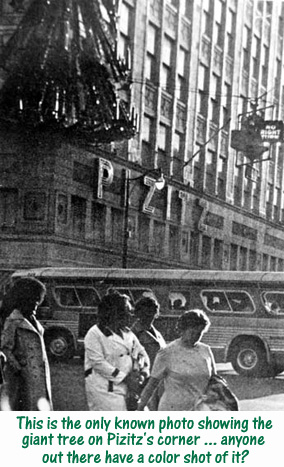 Until
the early 1960s, both stores were known for their animated Christmas window
displays, a common feature of department stores across the country -- but
somewhat surprisingly, even the local historical societies and photo collectors
have been unable to come up with actual photos of any of these. It was
in 1964 that Pizitz's sales promotion department hit upon an idea that
would prove to be their ultimate ammunition in the annual yuletide war.
Some smart elf had the brilliant idea that if window displays could draw
immense crowds to the sidewalks outside the store, a similar feature inside
the store could be more than worth its cost in the numbers of shoppers
who would be passing through the doors. And, they reasoned, putting such
a display on the sixth floor would ensure that customers had to pass through
the lower five levels before getting to it! And so was born the Enchanted
Forest.
Until
the early 1960s, both stores were known for their animated Christmas window
displays, a common feature of department stores across the country -- but
somewhat surprisingly, even the local historical societies and photo collectors
have been unable to come up with actual photos of any of these. It was
in 1964 that Pizitz's sales promotion department hit upon an idea that
would prove to be their ultimate ammunition in the annual yuletide war.
Some smart elf had the brilliant idea that if window displays could draw
immense crowds to the sidewalks outside the store, a similar feature inside
the store could be more than worth its cost in the numbers of shoppers
who would be passing through the doors. And, they reasoned, putting such
a display on the sixth floor would ensure that customers had to pass through
the lower five levels before getting to it! And so was born the Enchanted
Forest.
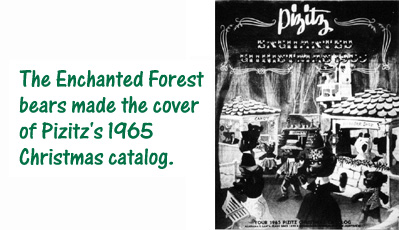 The
Enchanted Forest and its bears were such a hit that the attraction was
repeated in 1965, 1966, and 1967 with very few changes. The bears remained
the stars. Then, in 1968, with the original figures rapidly wearing out,
a new approach was taken. Now the Enchanted Forest became the home to Santa
Claus and his whole holiday crew. A 1968 newspaper ad proclaimed: "SEE
the little elves in their candy kitchens preparing Christmas goodies! WATCH
the cascading waterfall and the little goldfish swimming! LOOK at
the elves as they stitch 'n' sew away! VISIT Santa's stables! SEE the reindeer
being groomed and curried for their big ride! GREET Santa! He's waiting
at the end of the trail to meet you! FREE balloons when you visit the Enchanted
Forest and Santa on the Sixth Floor!"
The
Enchanted Forest and its bears were such a hit that the attraction was
repeated in 1965, 1966, and 1967 with very few changes. The bears remained
the stars. Then, in 1968, with the original figures rapidly wearing out,
a new approach was taken. Now the Enchanted Forest became the home to Santa
Claus and his whole holiday crew. A 1968 newspaper ad proclaimed: "SEE
the little elves in their candy kitchens preparing Christmas goodies! WATCH
the cascading waterfall and the little goldfish swimming! LOOK at
the elves as they stitch 'n' sew away! VISIT Santa's stables! SEE the reindeer
being groomed and curried for their big ride! GREET Santa! He's waiting
at the end of the trail to meet you! FREE balloons when you visit the Enchanted
Forest and Santa on the Sixth Floor!"
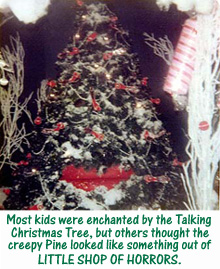
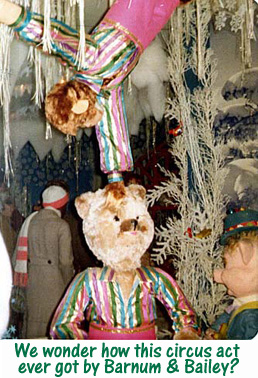
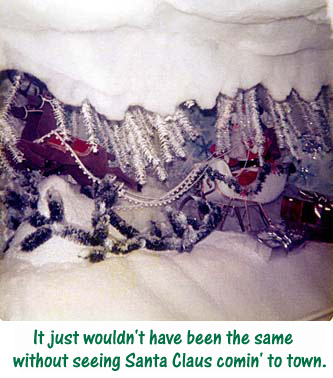
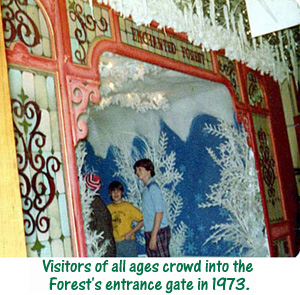 The
Forest appeared to have a universal appeal to all ages. Nowhere was this
better proven than in the mix of people found standing in line to look
at the animated elves and animals. Children, parents, grandparents, and
even jaded adolescents could be found gazing at the Forest's wonders with
equal delight. In fact, according to Jim Luker, the Forest's biggest fan
of all was Isadore Pizitz, who had succeeded his late father Louis
as leader of the retail institution. Luker reports: "Every year, Mr. Isadore
insisted on being the first one to tour the Forest before it opened to
the public. He would always come out just shaking his head in amazement."
The
Forest appeared to have a universal appeal to all ages. Nowhere was this
better proven than in the mix of people found standing in line to look
at the animated elves and animals. Children, parents, grandparents, and
even jaded adolescents could be found gazing at the Forest's wonders with
equal delight. In fact, according to Jim Luker, the Forest's biggest fan
of all was Isadore Pizitz, who had succeeded his late father Louis
as leader of the retail institution. Luker reports: "Every year, Mr. Isadore
insisted on being the first one to tour the Forest before it opened to
the public. He would always come out just shaking his head in amazement."
